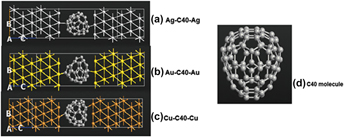Published online by Cambridge University Press: 30 August 2016

We calculate, compare, and discuss the charge transport properties through quasi fullerene C40 obtained in three different electrode–C40–electrode testbeds by employing density functional theory combined with nonequilibrium Green's function, to predict the electronic structure of molecular junctions formed from copper, silver, and gold electrodes. We investigate various metrics such as chemical potential of electrodes, density of states, transmission spectra, Mulliken population, and molecular projected self-consistent Hamiltonian eigen states to develop a novel insight about the varying transport phenomenon as the metallic part of the scattering region is modified. We conclude that all the junctions exhibit strong metallic character displaying ballistic conductance of order of more than G 0 accompanied by pronounced ripples in their conductance spectrum and small rectifying behavior in their current spectrum. This rectifying behavior is found to stem from the asymmetric shifting of orbital energies with changing bias voltage due to change in relative charge transfer through central molecule C40.